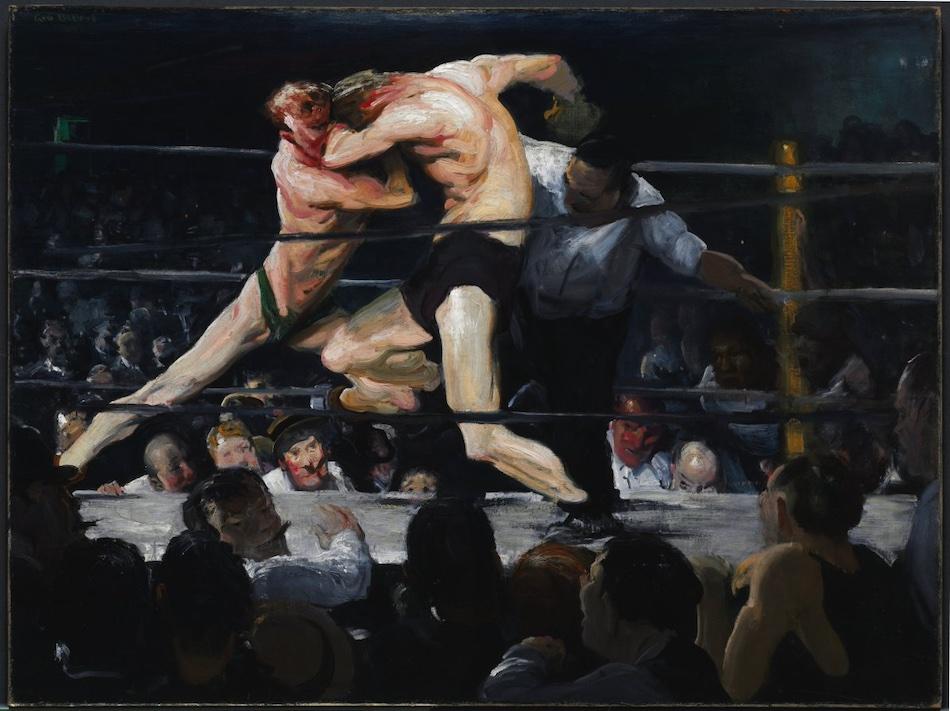
Stag at Sharkey's, 1909. George Bellows (American, 1882–1925). Oil on canvas; framed: 110 x 140.5 x 8.5 cm (43 5/16 x 55 5/16 x 3 3/8 in.); unframed: 92 x 122.6 cm (36 1/4 x 48 1/4 in.).
Founded in 1913 “for the benefit of all the people forever,” the Cleveland Museum of Art opened in 1916. With more than 600,000 people visiting each year, the CMA is one of the most visited art museums in the world. Renowned for its collection of over 63,000 artworks from all over the world–spanning 6,000 years–the CMA exhibits paintings, sculptures, photographs, and installations, including Renaissance, Impressionist, Cubist and Pop art masterpieces. Recognized for its award-winning Open Access program, the CMA provides an important international forum for exhibitions, scholarship, and performing arts. General admission is always free of charge. The following list includes 10 must-see pieces in the extensive CMA collections.
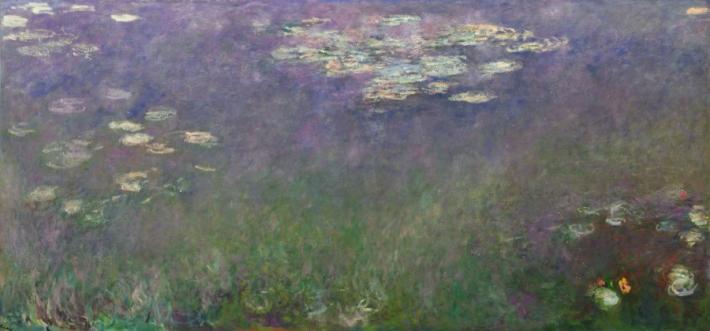
An avid gardener, French Impressionist Claude Monet (1840–1926) spent his last 30 years painting his garden in Giverny and created approximately 250 water lily compositions. A monumental view of his water lily pond shimmering in the sunlight, Water Lilies (Agapanthus), c. 1915–26, provides an immersive experience, transporting viewers to Monet’s garden at Giverny in order to contemplate the reflective pond that mirrors the sky and surrounding trees and provides a glimpse of the artist’s radical late work.
Image: Water Lilies (Agapanthus), c. 1915–26. Claude Monet (French, 1840–1926). Oil on canvas; framed: 204.9 x 430.3 x 6 cm (80 11/16 x 169 7/16 x 2 3/8 in.); unframed: 201.3 x 425.6 cm (79 1/4 x 167 9/16 in.).
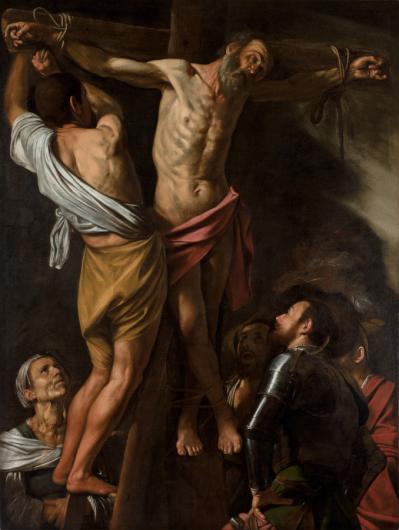
Infamous Italian painter (Michelangelo Merisi) Caravaggio (1571–1610)–who killed a man in a duel– utilized dramatic lighting and chiaroscuro, revolutionizing figurative religious painting with his intense, unsettling realism. Caravaggio created visually arresting, emotionally visceral paintings. The Crucifixion of Saint Andrew, 1606–7, is an excellent example of his work.
Image: The Crucifixion of Saint Andrew, 1606–7. Caravaggio (Italian, 1571–1610). Oil on canvas; framed: 233.5 x 184 x 12 cm (91 15/16 x 72 7/16 x 4 3/4 in.); unframed: 202.5 x 152.7 cm (79 3/4 x 60 1/8 in.).
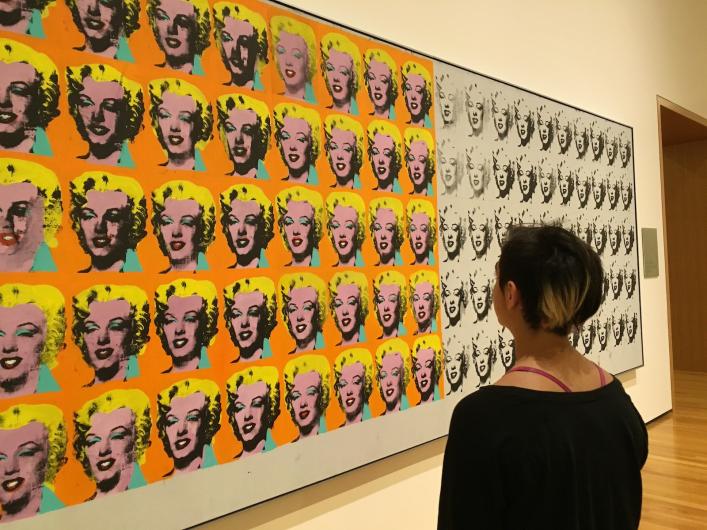
The son of Slovakian immigrants, American artist Andy Warhol (1928–1987) was one of the founders of Pop art. Inspired by commercial art and popular culture, Warhol was known for his bright silk screen paintings of recurring images. Arranged in five vertical rows that extend across a wall-length canvas, Marilyn x 100, 1962, showcases 100 prints of a headshot of iconic film star, Marilyn Monroe. Half are in color, half in black and white.
Image: Marilyn x 100, 1962. Installation view. Andy Warhol (American, 1928–1987) Screenprint ink and synthetic polymer paint on canvas; framed: 210.2 x 573.2 x 6.4 cm (82 3/4 x 225 11/16 x 2 1/2 in.); unframed: 205.7 x 567.7 cm (81 x 223 1/2 in.)
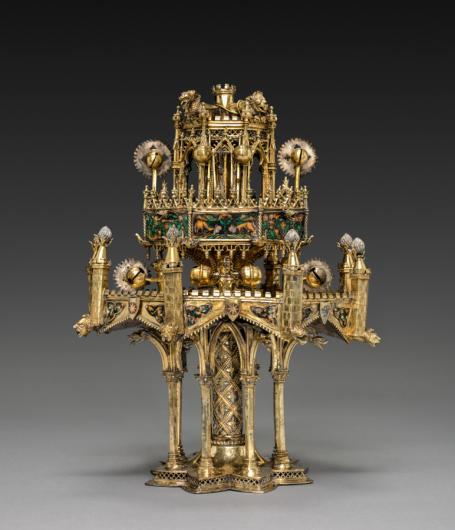
This Table Fountain, c.1320–40, created by an unknown French artist, is an impressive three tiered miniature architectural assemblage–made of gilt-silver and translucent enamels–combining features from Gothic cathedrals and castles. Adorned with miniature water wheels and tiny bells, the working fountain would have jingled musically as water passed under its pointed arches and crenelated battlements, to spout out through the grotesque gargoyles’ mouths. While table fountains were particularly elaborate symbols of Medieval wealth and status, this is believed to be the only intact example.
Image: Table Fountain, c. 1320–40. France, Paris. Gilt-silver and translucent enamels; overall: 33.8 x 25.4 x 26 cm (13 5/16 x 10 x 10 1/4 in.).
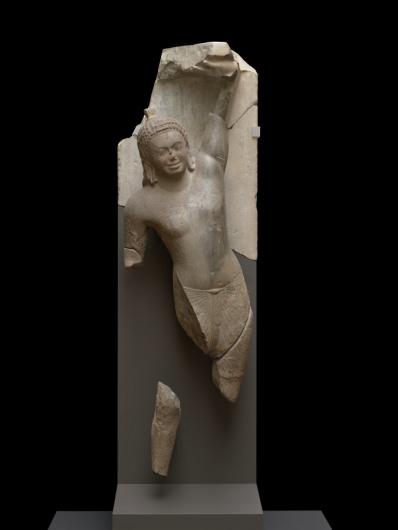
Recovered from the outskirts of the ancient urban center Angkor Borei, this masterful early Cambodian sculpture, Krishna lifting Mount Govardhan c. 600, depicts the Hindu god Krishna cheerfully holding up a mountain one handed to protect his community from torrential storms.
Image: Krishna Lifting Mount Govardhan, c. 600. Southern Cambodia, Takeo Province, Phnom Da. Sandstone; overall: 203.1 x 68 x 55.5 cm (79 15/16 x 26 3/4 x 21 7/8 in.).
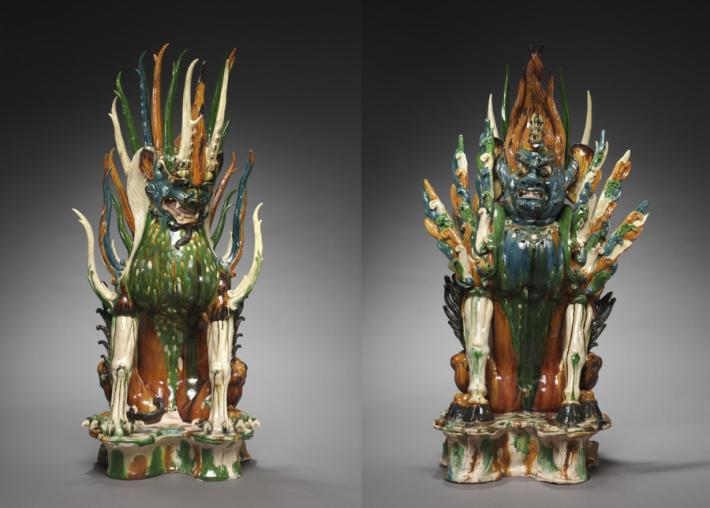
These fierce and fantastical sculpted ceramic Chinese Tomb Guardians, c. early 700s, sit on their haunches, glaring protectively. Glazed in green, amber and transparent white, with expensive cobalt blue accents signaling high social status, these guardian qitou–earth spirits–ward off evil, and keep the deceased soul from wandering. One has clawed haunches and forepaws, its leonine face crowned with antlers. The other has hooves, a humanistic face and curved horns. Beautiful but lethal looking spikes fan out from their backs.
Image: Tomb Guardians, early 700s. China, probably Shaanxi province, Xi'an, Tang dynasty (618-907). Glazed earthenware, sancai (three-color) ware; part 1: 92.3 x 43.8 x 41.9 cm (36 5/16 x 17 1/4 x 16 1/2 in.); part 2: 88.9 x 41 x 50.8 cm (35 x 16 1/8 x 20 in.).
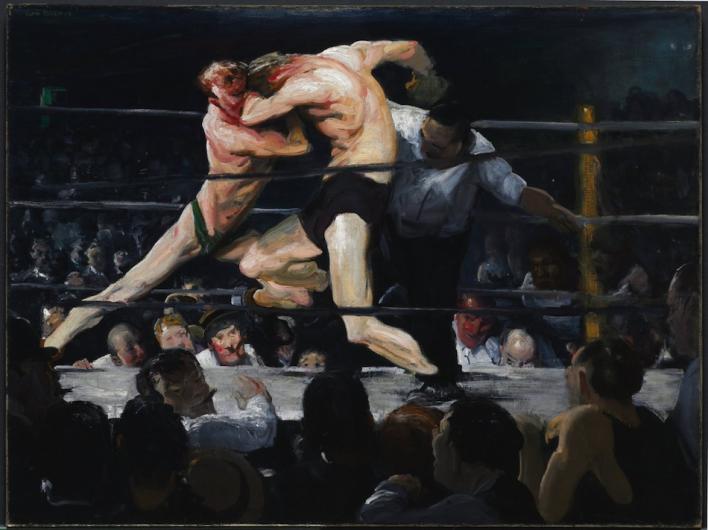
A dramatically kinetic oil painting capturing the energy and movement of a boxing match, Stag at Sharkey's, 1909, was painted by American George Bellows (1882–1925). It depicts two boxers surging into each other, while a referee– with arms outstretched, making a call–behind them, as the raucous crowd surrounding the ring looks on. Public boxing was illegal in New York at the time, so bouts had to be sponsored by private clubs. Fighters given temporary membership to compete were called ‘stags.’
Image: Stag at Sharkey's, 1909. George Bellows (American, 1882–1925). Oil on canvas; framed: 110 x 140.5 x 8.5 cm (43 5/16 x 55 5/16 x 3 3/8 in.); unframed: 92 x 122.6 cm (36 1/4 x 48 1/4 in.).
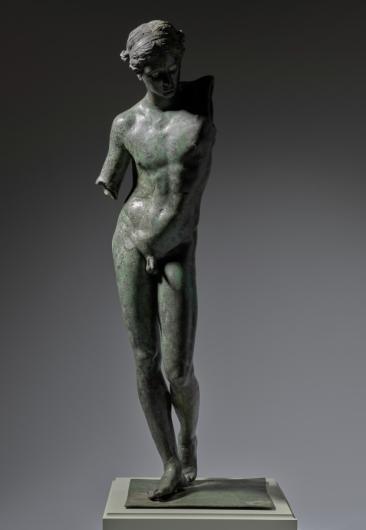
The only surviving large-scale bronze sculpture of its kind, The Cleveland Apollo: Apollo Sauroktonos (Lizard-Slayer) or Apollo the Python-Slayer, c. 350–200 BCE, by an Athenian sculptor, depicts the highly realistic nude adolescent god standing on his right leg as he leans left to take aim at the serpent.
Image: The Cleveland Apollo: Apollo Sauroktonos (Lizard-Slayer) or Apollo the Python-Slayer, c. 350–200 BCE. Attributed to Praxiteles (Greek, Athenian, c. 400–330 BCE), or Follower. Bronze, copper, and stone inlay; base: 0.5 x 47.3 x 40.7 cm (3/16 x 18 5/8 x 16 in.); overall: 150 x 50.3 x 66.8 cm (59 1/16 x 19 13/16 x 26 5/16 in.).
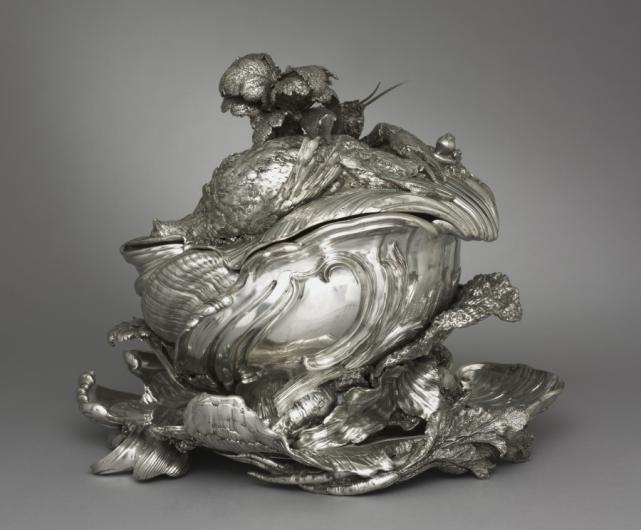
Designed by Juste-Aurèle Meissonnier (1695–1750), one of Louis XV’s official architects, this silver Rococo Covered Tureen on Stand (Pot-à-oille), 1735–38, makes a soup pot into a decadent usable art piece. Its bowl–adorned with shell-like whorls– sits on a bed of leaves and root vegetables that seem to swirl and crest like waves. Its ornate curved lid is topped with a lobster-like crustacean, a pigeon and some leafy greens.
Image: Covered Tureen on Stand (Pot-à-oille), 1735–38. Juste-Aurèle Meissonnier (French, 1695–1750), Pierre-François Bonnestrenne (French), Henry Adnet (French, 1745). Silver; overall: 36.9 x 38.4 x 31.8 cm (14 1/2 x 15 1/8 x 12 1/2 in.); average: 35 x 38.4 x 31.8 cm (13 3/4 x 15 1/8 x 12 1/2 in.).
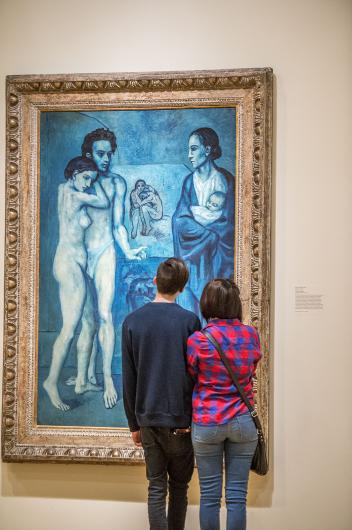
Made during his Blue Period, the striking La Vie, 1903, by iconic Spanish artist Pablo Picasso (1881–1973), is rendered in cool colors suggestive of night, mystery, dreams and death. A partially nude couple faces a stern blue-robed woman holding an infant. Sketches of sadly crouching figures line the wall behind them. The subject has been interpreted variously as a symbolic representation of sacred and profane love or the cycle of life, or a realistic portrayal of a working-class couple facing the hazards of real life.
Image: La Vie, 1903. Installation view. Pablo Picasso (Spanish, 1881–1973), Oil on canvas; framed: 239 x 170 x 10 cm (94 1/8 x 66 15/16 x 3 15/16 in.); unframed: 196.5 x 129.2 cm (77 3/8 x 50 7/8 in.)
Megan D Robinson
Megan D Robinson writes for Art & Object and the Iowa Source.























